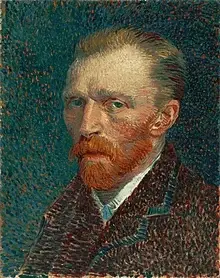Pointillism is the use of tiny, distinct dots of colour that are added in patterns to create a picture in this painting technique.

In 1886, Georges Seurat and Paul Signac developed the technique as a branch of Impressionism. The word “Pointillism” was coined by art critics in the late 1880s to mock these artists’ work, but it is now used without the negative connotation it once had. Neo-impressionism is the movement that Seurat started with this technique. The Divisionists used a similar pattern-forming method, but with larger cube-like brushstrokes.
Vincent van Gogh, Self Portrait, 1887
The Technique
The technique depends on the viewer’s ability to mix the colour spots into a wider variety of tones using their eyes and minds. Divisionism, a more technical version of the process, is similar to it. Colour theory is the subject of divisionism, while pointillism is more concerned with the basic type of brushwork used to apply the paint. It’s a technique used by only a few serious artists nowadays, but it can be seen in the works of Seurat, Signac, and Cross. However, consider Andy Warhol’s early works as well as Pop Art.
From 1905 to 1907, Robert Delaunay and Jean Metzinger painted large squares or ‘cubes’ of colour in a Divisionist style: the size and direction of each gave the painting a sense of rhythm, but colour varied independently of size and placement. This form of Divisionism was a major move forward from Signac and Cross’s concerns. In 1906, art critic Louis Chassevent noticed the difference and coined the term “cube,” which was later adopted by Louis Vauxcelles to christen Cubism, according to art historian Daniel Robbins.
The Practice
The typical techniques of mixing pigments on a palette are in stark contrast to Pointillism. Pointillism is similar to the four-colour CMYK printing method used by some colour printers and large presses, which uses dots of cyan, magenta, yellow, and key to creating a finished product (black). Red, Green, and Blue (RGB) colours are used in televisions and computer monitors to reflect picture colours.
As the additive primaries of red, blue, and green light (the additive primaries) are combined, the effect is something that looks like white light (see Prism (optics)). While painting is essentially subtractive, Pointillist colours are always brighter than mixed subtractive colours. This may be due to the pigments not being mixed in a subtractive manner, as well as the fact that any of the white canvas could be seen between the dots.
The conventional brushwork used to delineate texture is sacrificed in favour of the drawing process used by Pointillist colour mixing.
Oil paint is used by the bulk of Pointillism. Oils are favoured over other mediums because of their thickness and lack of ability to run or bleed.
Common uses of Pointillism In History
In the seventeenth century, pointillé was widely used for the elaborate binding of hand-made book covers, the decoration of metallic weapons and armour, and the decoration of hand-finished firearms.
Famous Pointillism Artworks

Georges Seurat, 1884–1886, A Sunday Afternoon on the Island of La Grande Jatte, oil on canvas.
Georges Seurat portrayed people sitting in a residential park on the island of La Grande Jatte in the Seine River in his best-known and largest painting. Beginning in 1884 with a sheet of thin horizontal brushstrokes in contrasting colours, the artist collaborated on the artwork in many campaigns. As seen from a distance, he incorporated tiny dots in contrasting colours that appear as solid and luminous shapes. Seurat’s use of this extremely formal and “scientific” technique, later dubbed Pointillism, set him apart from the Impressionists’ more intuitive approach to drawing. Seurat, like Claude Monet and Pierre-Auguste Renoir, accepted the subject matter of everyday life, but he went beyond their concern for capturing the spontaneous and immediate quality of light in nature.

Georges Seurat, 1884, Bathers at Asnières, oil on canvas,

Maximilien Luce, Morning, Interior, 1890
Information Citations
En.wikipedia.org, https://en.wikipedia.org/.






















